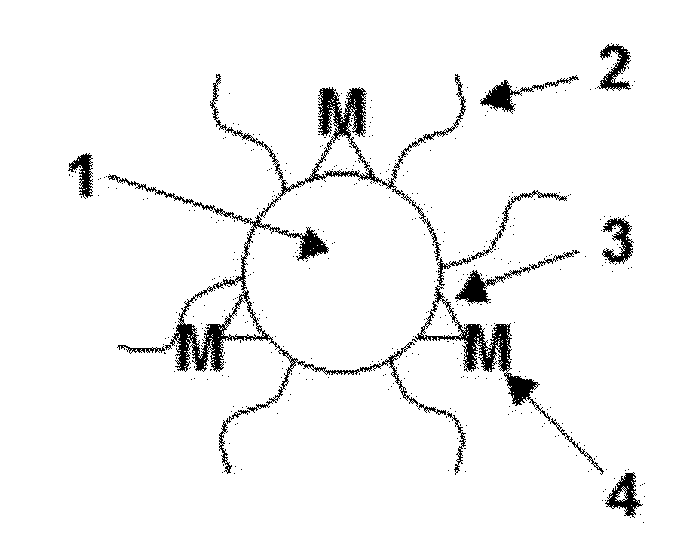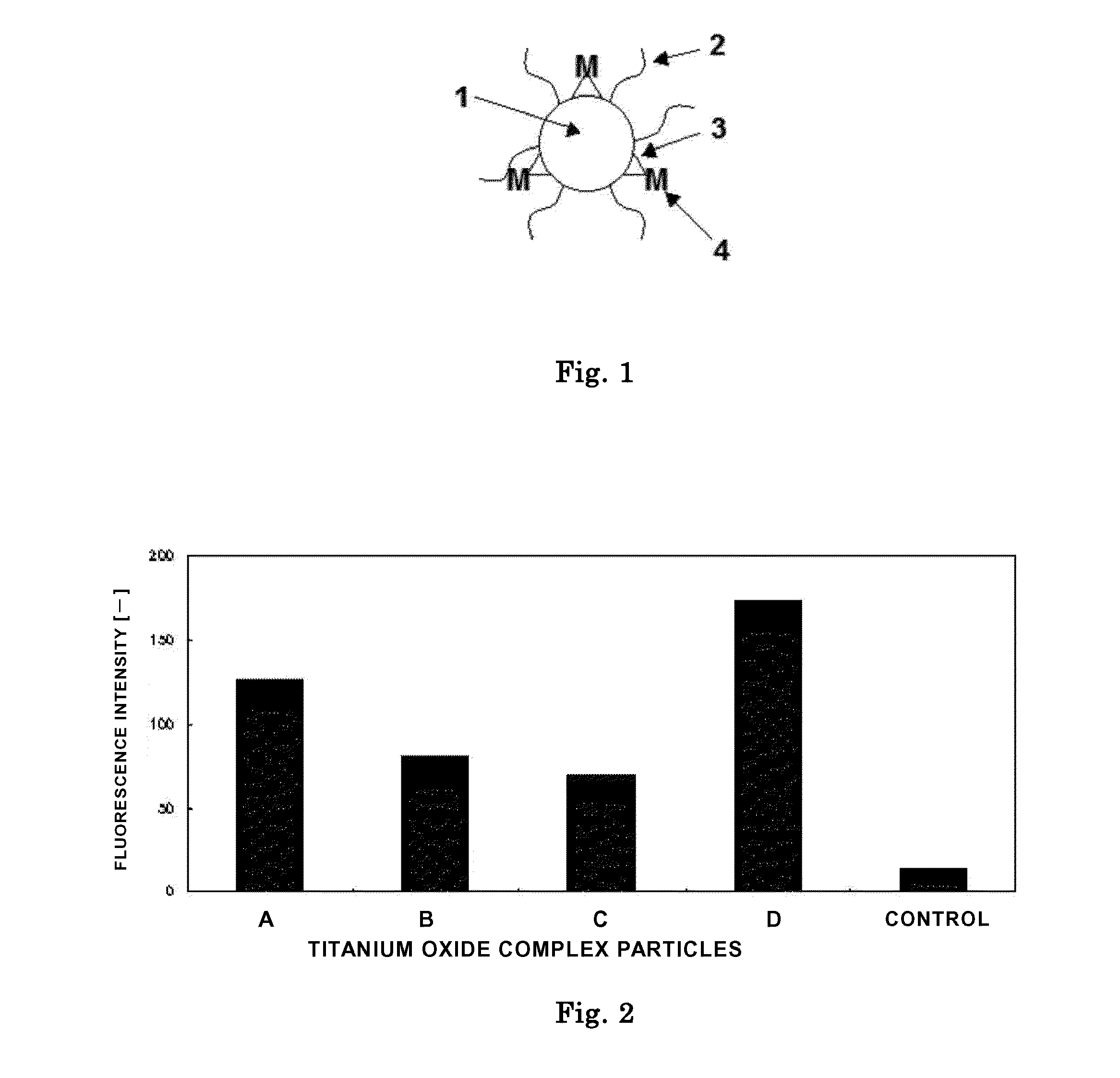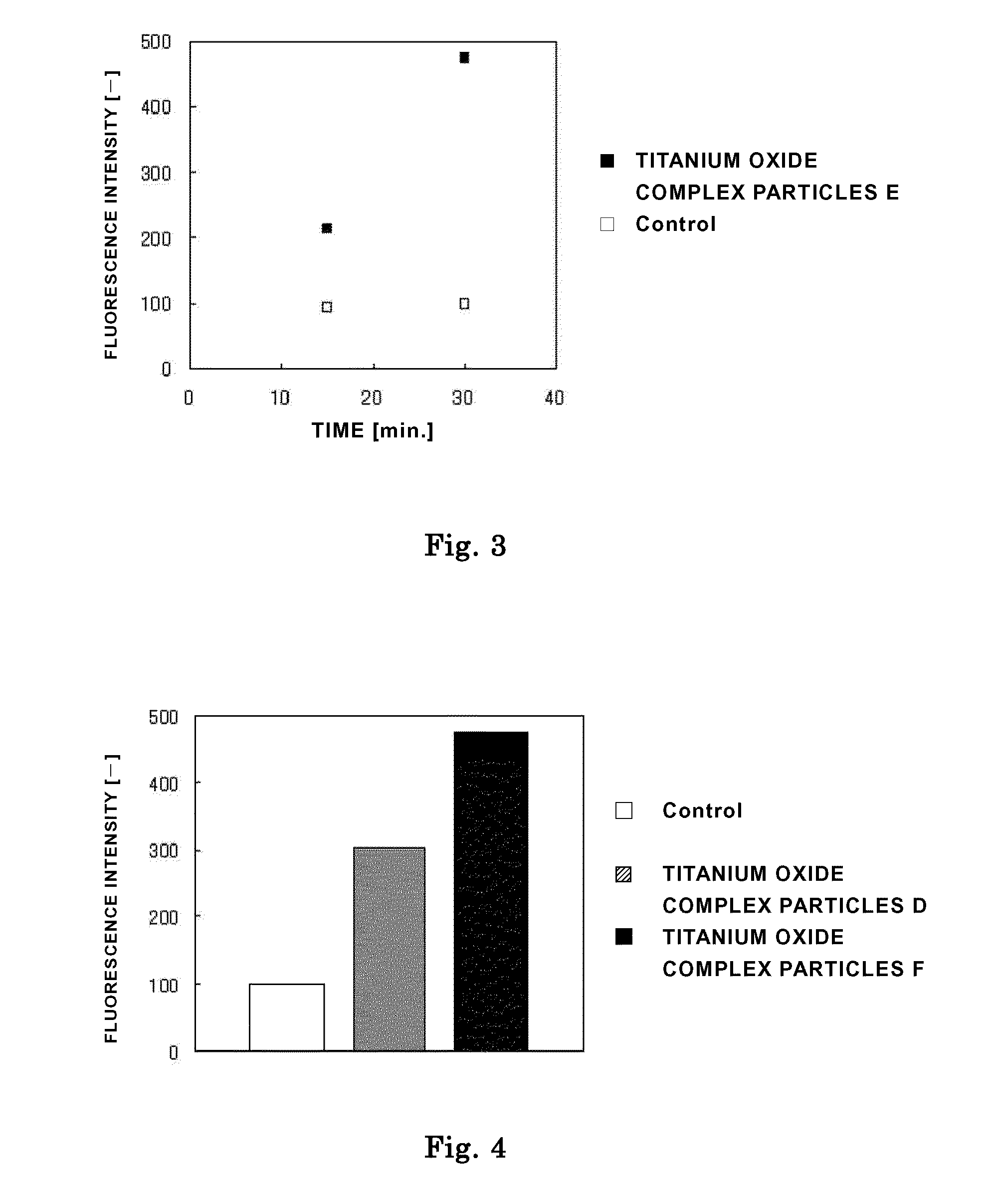Ultrasonic cancer therapy accelerator
a technology of ultrasonic radiation and accelerator, which is applied in the direction of titanium organic compounds, organic active ingredients, powder delivery, etc., can solve the problems of inability to achieve stable dispersibility in in-vivo environments, no study has been made on the utilization of fenton reactions, and inability to evenly disperse titanium oxide particles in aqueous solvents. achieve the effect of maintaining dispersibility and catalytic activity
- Summary
- Abstract
- Description
- Claims
- Application Information
AI Technical Summary
Benefits of technology
Problems solved by technology
Method used
Image
Examples
example 1
Preparation of Polyethylene Glycol-Bound Titanium Oxide Complex Particles
[0074]Titanium tetraisopropoxide (3.6 g) and 3.6 g of isopropanol were mixed together, and the mixture was added dropwise to 60 ml of ultrapure water under ice cooling for hydrolysis. After the completion of the dropwise addition, the reaction solution was stirred at room temperature for 30 min. After the stirring, 1 ml of 12 N nitric acid was added dropwise thereto, and the mixture was stirred for peptization at 80° C. for 8 hr. After the completion of the peptization, the reaction solution was filtered through a 0.45 μm filter and was further subjected to solution exchange through a desalination column PD-10 (manufactured by GE Health Care Bioscience) to prepare an acidic titanium oxide sol having a solid content of 1%. The titanium oxide sol was placed in a 100 ml-volume vial bottle, followed by ultrasonication at 200 kHz with an ultrasonic generator MIDSONIC 200 (manufactured by Kaijo Corporation) for 30 mi...
example 2
Preparation of Polyacrylic Acid-Bound Titanium Oxide Complex Particles
[0077]The procedure of Example 1 was repeated to finally prepare an acidic titanium oxide sol having a solid content of 20%.
[0078]The acidic titanium oxide sol (0.6 ml) was diluted with dimethylformamide (DMF) to a volume of 20 ml to disperse the titanium oxide in DMF. A solution (10 ml) of 0.3 g of polyacrylic acid (manufactured by Wako Pure Chemical Industries, Ltd.) having an average molecular weight of 5000 in DMF was added to the dispersion, followed by stirring for mixing. The solution was transferred to a hydrothermal reaction vessel HU-50 (manufactured by SAN-Al Science Co. Ltd.), and a reaction was allowed to proceed with heating at 150° C. for 5 hr. After the completion of the reaction, the solution was cooled until the temperature of the reaction vessel reached a temperature of 50° C. or below. Isopropanol in an amount of two times that of the amount of the reaction solution was added to the reaction so...
example 3
Preparation of Polyethylene Imine-Bound Titanium Oxide Complex Particles
[0079]The procedure of Example 1 was repeated to finally prepare an acidic titanium oxide sol having a solid content of 20%.
[0080]The titanium oxide sol (3 ml) was dispersed in 20 ml of dimethylformamide (DMF). A solution (10 ml) of 450 mg of polyethylene imine having an average molecular weight of 10000 (manufactured by Wako Pure Chemical Industries, Ltd.) dissolved in DMF was added to the dispersion, followed by stirring for mixing. The solution was transferred to a hydrothermal reaction vessel HU-50 (manufactured by SAN-Al Science Co. Ltd.), and a reaction was allowed to proceed with heating at 150° C. for 5 hr. After the completion of the reaction, the solution was cooled until the temperature of the reaction vessel reached a temperature of 50° C. or below. Acetone in an amount of two times that of the amount of the reaction solution was added to the reaction solution. The mixture was allowed to stand at roo...
PUM
| Property | Measurement | Unit |
|---|---|---|
| Percent by mass | aaaaa | aaaaa |
| Acidity | aaaaa | aaaaa |
| Substance count | aaaaa | aaaaa |
Abstract
Description
Claims
Application Information
 Login to View More
Login to View More - R&D
- Intellectual Property
- Life Sciences
- Materials
- Tech Scout
- Unparalleled Data Quality
- Higher Quality Content
- 60% Fewer Hallucinations
Browse by: Latest US Patents, China's latest patents, Technical Efficacy Thesaurus, Application Domain, Technology Topic, Popular Technical Reports.
© 2025 PatSnap. All rights reserved.Legal|Privacy policy|Modern Slavery Act Transparency Statement|Sitemap|About US| Contact US: help@patsnap.com



